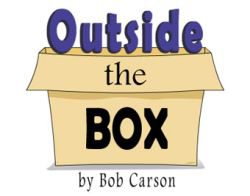Spring Fever Remedies
March 25, 2019,Editor’s Note: The USTA website is pleased to present freelance writer Bob Carson and his popular “Outside the Box” features. This monthly series is a menu of outlandish proposals presented with a wink — but the purpose behind them is serious. The views contained in this column are that of the author alone, and do not necessarily represent the opinions or views of the United States Trotting Association.
The length of time between the gavel falling on your yearling purchase and the first time your 2-year-old approaches the starting gate feels like an eternity for an owner. Unless you live within easy driving distance of the training facility, for months all you will see is a parade of bills and staking payments. This abyss of nothingness does not help participation in our sport.
The incremental progress of a young horse in training is intriguing. Trainers and grooms can touch, feel and sell the 2-year-olds and returning 3-year-olds. They see the progress. Alas, the owners do not share in this experience nearly as much as they should — or could.
These early months of oblivion are tiresome for veteran owners. They are also an obstacle for introducing new owners to our sport. Looking at the yearling ownership process objectively, owners write a huge check at the sale and then they write a string of training checks with virtually zero action for a long time. Sadly, training down to 2:30 may be the only action some horses have the ability to provide.
 This is not new. This long span of time without action or interaction during the long winter and spring has always been a problem for our sport. In this era of instant gratification, the slowness seems exaggerated. What is new is that technology can help fill the void.
This is not new. This long span of time without action or interaction during the long winter and spring has always been a problem for our sport. In this era of instant gratification, the slowness seems exaggerated. What is new is that technology can help fill the void.
The Stable in Canada is on the right track. Anthony MacDonald and his team make an effort to keep owners involved during the off-season. They are ahead of the curve with video reports and drone broadcasts of yearlings in training. These innovations will become commonplace in the future.
Let’s spitball a few other ideas or methods where trainers or owners could shorten this long off-season. Granted, every long-distance training situation is different: small stable, large stable, young participants, old participants, tech-savvy and luddites. The following are merely concepts to consider, not blueprints.
• Operating a drone is not feasible for many trainers, at least not yet so let us come back to earth. Mounting a wireless security camera system could let owners watch their yearlings in action. Merely re-purpose a high-end home security system to watch your horse instead of deliverymen and burglars.
The ability to watch jogging and training miles on an owner’s device would take a lot of the boredom out of long-distance ownership. The technology is so good that the digital view might actually be better than a live visit. In addition, recording, replaying and slowing down the live feed of training miles is possible. After beta testing this idea at a training center, a future OTB will report how this works out.
• Owners hunger for feedback on their investment. Many owners avoid pestering a trainer with profound questions like “How’s my horse doing?” Technology could help this dilemma. While emailing or texting each owner a regular report is too extreme, and many weeks there is not much to report, perhaps a simple digital form that allows the trainer to fill in a few simple nuggets of information would be useful.
This would not require anything extensive, just type in the approximate times of training miles and jogging, track conditions, equipment changes, maybe one sentence of something the trainer is working on. This would only take a few seconds for the trainer and would be a welcome little break for owners during the long voids.
• If a large percentage of the ownership base is relatively close to the facility, trainers could designate a few Saturdays each year as a scheduled visiting day. On this morning, owners would meet for coffee and doughnuts and receive a printed sheet with organized sets of miles and the names of the horses and owners. Maybe meet at a local café for lunch to end the day. If the trainers are in a southern state for training, a similar day or two every season could be scheduled that would allow owners to plan vacations. Of course, the weather can always foil plans, but everyone knows that will happen.
• This idea could be tricky and would require judgment calls, but in some cases, delegating could be good for all parties. When a trainer has a large number of babies in training, they will often have second trainers who spend most of the time behind your horse. If the head trainer has a comfort level, linking this second trainer to the owner via Skype, text, or email could help fill the information void. Grooms could fill this role as a communication hub if they are technologically gifted and personable.
• Returning to the visual connection, while drones or mounted cameras might be a bridge too far for some trainers, any four-year-old has the ability to Skype. As an owner, if on occasion the trainer calls and says he is going a mile on Thursday and he will have someone Skype me to view it, I would be grateful. This effort seems like a small thing, but it would take a bite out of those long stretches of nothingness.
The explosion of technology has built a different world. We can live virtual lives where we rarely leave our homes. These ever-present, omnipotent cameras and devices allow us to do so many things. Digitally linking horses to the customer may be a bit of an imposition on some trainers but they would be wise to keep their digital eyes open because this can extend the reach of a stable and improve the services offered. Technology offers a lifeline that might be the difference in keeping owners in the game. All lifelines to our brave little boat are helpful.
Technology giveth and technology taketh away. Closing the troubling gap between those first days of training and that first race would be helpful. New devices can allow owners to watch their dreams come true. Harness racing trainers and owners should taketh that step.

